
| Start | Island / Iceland | Bestellung | Links | Kontakt |
In the middle of foxland "Fox, you have stolen the goose," I am humming – I have heard the melody often in the last weeks when the five year old Sunna practiced on her little violin. But now I am no longer in South Iceland but in the East, I am walking through the groves of Vallanes. There are white feathers hanging in the yet leafless shrubbery. It must have been rather a ptarmigan than a goose, the fox has caught. 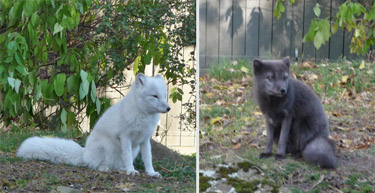
A brown or a white fox? The fox question irritate even seasoned Icelanders. The white one lived in Iceland already before the settlement, all agree. Some have the adventurous theory that the Vikings would have taken the brown one with them. To general confusion, there is a white and a brown fox in the little zoo of Reykjavík – at this juncture, who dare to argue that the white one would change it's coat in summer? I meet him early in the morning. It is a brown fox who is in a great hurry and, with his wafting tail, he looks as busy as a clerk on his way to the morning meeting. Like all intelligent animals, he uses the human-made road of course. He disappears behind the next hill without having noticed me. 
Nearby there is the well preserved skeleton of a sheep which seems to have served as food for foxes and ravens in the winter. The ravens themselves, however, fall victim – four of this beautiful black birds are lying on the edge of the fields one day – how and why they died remains mysterious. There are also some (unsustainable) theories. One says they has overeaten on the new sowed barley. But also the smaller birds, snipes, golden plowers, gulls, redwings and geese pecked from the barley seed day and night till the rain comes in-mid-May after a long dry period. 
Now a green fluff is covering the fields and on its edges the new grass is peeping through the faded one. The lush green attracts animals believed to be shy. One morning, around 20 quadrupeds having breakfast are standing in front of my window. In the morning or in the evening – the herd of reindeer now comes to the farm daily. If bothered they go away without rushing. The reindeer just taking off their white winter coat and dressing in darker colors are only interested in the new grass and do not touch the barley. The three outlaws however – a black spotted ewe and two white teenage rams – settled unauthorizedly on the farm area of Vallanes and residing on the cliffs above the grove like outlawed saga heroes, are trying to attack the neighbored barley field again and again. 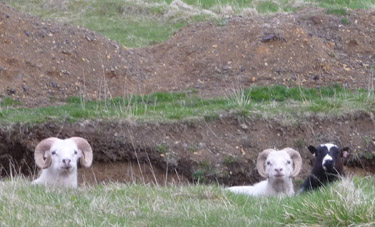
But not a single animal seems to be interested in njóli which now begins to grow rampant despite our efforts to pull it out of the new plowed fields. Njóli, in English Northern dock, looks similar to sorrel but do not taste as good. Containing a lot of oxalic acid, it is not digestible. The dock seed was send from Denmark as a "royal gift" in the end of the 18th century and should save the Icelander from dying of starvation. The idea originated from the royal gardener and castle's administrator Schmidt who recommended in the year 1778 to use this fast-growing plant which was eager to reproduce to provide the Danish subjects in the cooler parts of the kingdom Norway, Greenland and Iceland. 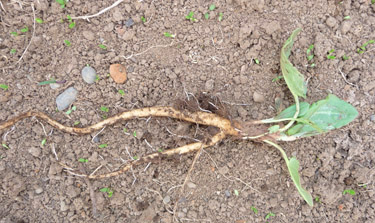
But it was not the king who blessed his subjects with the njóli seeds, because Christian VII was not able to govern as you know from the novel The Visit of the Royal Physician by Per Olov Enquist. It was his half brother Frederick, one of the central figures in Struensee's downfall in the year 1772, who governed Denmark till 1786 with the assistance of his mother, descending from the Brunswick ducal dynasty. But Frederick was not king but only hereditary prince. Nevertheless people in Iceland spoke gratefully of the gift of the "beloved king". 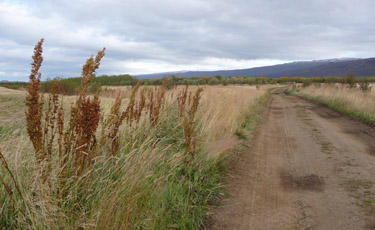
Prince Frederick had instructed the Icelanders to spread the njóli seed in yards and fields but obviously he had forgotten to explain what they should do with this plants. And because the Icelanders did not know that they should cook and eat the dock, they rather dropped it and survived anyhow. The "royal gift" is of lasting value and high sustainability, but – I dread to say it – it is the worst sort of weed on the Icelandic fields and a real curse. 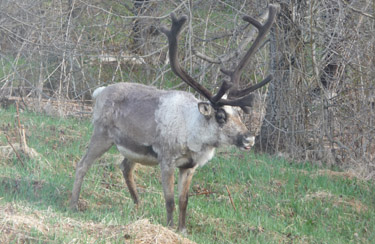
I have still to note that the reindeer – the first 13 were brought to Iceland in 1771 (in the Struensee period yet) – were not named gift of the "beloved king". They missed their original purpose as well because one had forgotten in Copenhagen to supply the manual for domestication, but they are a pleasant sight, they attract tourists to East Iceland and they deliver a delicious meat in the autumn hunting season. --------Rough translation of Wo sich Fuchs und Ren guten Morgen sagen, by Bernhild Vögel, in Iceland Review (German version), June 21, 2010 back to content |